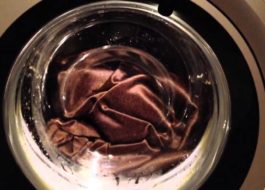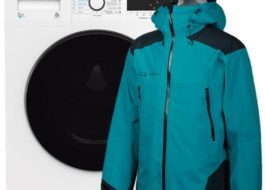How to wash tulle in an automatic washing machine
 Previously, housewives washed thin lace curtains only on their hands, not trusting activator washers, which could ruin light fabric with aggressive mechanics and asynchronous operation. Modern machines are much more gentle and reliable, so the risk of unpleasant surprises is reduced to zero. True, there is one “but” - it is important to wash the tulle correctly in the washing machine and use suitable detergents. These and other important nuances will be discussed below.
Previously, housewives washed thin lace curtains only on their hands, not trusting activator washers, which could ruin light fabric with aggressive mechanics and asynchronous operation. Modern machines are much more gentle and reliable, so the risk of unpleasant surprises is reduced to zero. True, there is one “but” - it is important to wash the tulle correctly in the washing machine and use suitable detergents. These and other important nuances will be discussed below.
Description of the machine washing process
There are no separate rules for machine washing tulle curtains, but there are step-by-step instructions. No special manipulations are required - on the contrary, only the most delicate handling. We act according to a proven scheme.
- Take the tulle and shake it thoroughly in the fresh air. We remember that dust and dirt accumulate on the curtains.
- Carefully fold and place in the machine. Wrinkled fabric will cause severe creases. Ideally, we place the fabrics in a special protective bag, especially when muslin, lace, border, muslin, veil or organza with fine embroidery are placed in the drum.
Important! It is recommended to check whether the hooks are securely fastened to the tulle to prevent them from breaking off and falling into the tank.
- We choose a delicate, hand wash, program for silk or wool. The general parameters are the same - 30 degrees, minimal spin and plenty of rinsing. The drum will rotate softly and smoothly, and a large amount of water will protect the fabric from damage.Finding a suitable button is not difficult: on ARDO washing machines we look for an icon with the image of a feather or a hand with a basin, on Ariston – a flower, on Bosch – a dress with a butterfly, on Indesit – a top, on Zanussi – a flower and a hand lowered into a basin, on Candy – a feather, and for Electrolux - a flower, a moth, thread or a hand in a basin. Owners Beko, LG and Samsung is even simpler - everything is signed right on the control panel.

- Add/fill in half the volume of cleaning agent. We remember that excess powder or gel on mesh and lace fabrics will cause excessive foam formation. It is better to calculate the manufacturer’s recommended dosage in advance, and with a half load, halve it.
- We turn on the extra rinse option to thoroughly rinse the detergents from the curtains, otherwise the fabric will turn yellow prematurely. To do this, select the “Double Rinse” or “AquaPlus” key.
- At the end of the cycle, carefully take out the tulle, wait for the water to drain and, without squeezing, hang it on any crossbar. It is strictly forbidden to twist it; only gentle squeezing is permissible for large amounts of laundry.
These are the general rules for washing light fabrics in an automatic machine. But there are a few more nuances that are worth knowing to achieve an ideal result. We are talking about choosing a detergent, drying, ironing and bleaching the tulle.
How to dry and can it be ironed?
Tulle is contraindicated not only from spinning, but also from automatic drying in the washing machine. Just shake the fabric and hang it on a bar in the bathroom. In most cases, you can immediately return it to the window - the hung curtains will dry within a few hours without additional manipulation.
Crinkled fabrics, on the contrary, need to be twisted: ironing such tulle will stretch and ruin it.
It is not necessary to take out the iron - the tulle will smooth out under its own weight. If folds and kinks remain, then turn on the ironing at minimum settings and using cotton or gauze. A steamer that prevents direct contact of the lace with the heating surface of the iron is ideal.
We strictly adhere to the rules
It is a mistaken belief that tulle does not require special care and can withstand a standard cycle in an automatic washing machine. This is absolutely not true - thin materials will not withstand high temperatures. In water above 40°C or in contact with the soleplate of an iron heated to “3”, the drapery will irrevocably turn yellow, crumple or burn. Therefore, it is important to choose only the closest thing to hand washing, turn off spin drying and do not iron.
The mentioned rules apply to all types of tulle, including inexpensive nylon mesh curtains.
You should not engage in intensive cleaning of the fabric. All stains are removed quickly and easily, so pre-washing, soaking and aggressive stain removers are not required. The main thing is not to “neglect” their condition and wash them regularly, at least once every 3-4 months.. If there are stubborn stains, the residents are allergic to dust, or the curtains become dirty too quickly from kitchen grease or the mains outside the window - it is enough to increase the frequency of washing to once every 3 weeks.
What powder should I use?
One of the most important points is choosing the right detergent for washing tulle in a machine. The list of permitted compounds is quite wide. A review of the most popular options will help you decide:
Attention! It is recommended to choose the safest products from proven brands.
- Special products designed for thin and lace fabrics. Effective due to delicate bleaching and light starching. They are distributed through specialized “household” stores, but are distinguished by a high price and a limited assortment. Therefore, they are purchased only for expensive curtains.

- Detergent for delicate laundry. A semi-special product that is suitable for all delicate textures. It is gentle on the fabric structure, is easy to rinse and is designed to be washed in cold water.
- Baby powders and gels. Another non-aggressive product that will help remove yellowness from tulle and third-party contamination without harm or damage.
- Universal compositions. If you need to wash inexpensive mesh curtains, then it is not necessary to purchase expensive gels and conditioners.
The main thing is to pay attention to the purpose of the powder: for colored, dark or white fabrics. It would be a good idea to examine the composition for the presence of aggressive surfactants, phosphates and zeolites. Don't forget about dosage control.
Making tulle snow-white again
Even with the most careful washing, tulle loses its whiteness over time, turning yellow or gray. The problem is solved by bleaching, and this procedure can also be carried out in an automatic washing machine. To overcome the yellowness or grayness of fabric, you need to choose the right bleaching agent. The main thing is not to use chlorine-containing compounds - this element will completely ruin the thin material. We better pay attention to:
- Oxygen bleaches. Their main “plus” is strong and gentle whitening with long-term preservation of snow-white results.Among the advantages is its versatility, thanks to which both white and colored curtains can be washed, as well as the ability to eliminate dullness in cold water. But there is a significant “minus” - the high cost.
- Optical brighteners. These products lighten tulle with the help of special particles that settle on the material and visually make it whiter. Suitable only for non-colored linen, as the power of color washing out is quite strong. But you should not expect a stable and long-term result - you will have to repeat the procedure at least once a month.
We select the appropriate product option and add it to the tray with the washing powder in the required dosage. The amount depends on the degree of contamination - for heavily yellowed or grayed fabrics it increases. If you have an old curtain, we proceed differently: to keep it snow-white, you will have to soak it or use the pre-wash button.
For those who are afraid of using industrial bleaches, there is a safer alternative - home remedies. The simplest thing is to pour two tablespoons of table salt into the powder receptacle of the washing machine and turn on the pre-wash. To speed up the lightening process, it is recommended to add the same amount of powder or gel.
In order not to guess at what temperature to wash and what detergent to use, you need to follow the markings on the tulle and study the instructions for the washing machine. Then you can achieve a snow-white effect without risks and unpleasant consequences.
Interesting:
Reader comments
- Share your opinion - leave a comment
Categories
Washing machine repair


For buyers

For users

Dishwasher

















Add a comment